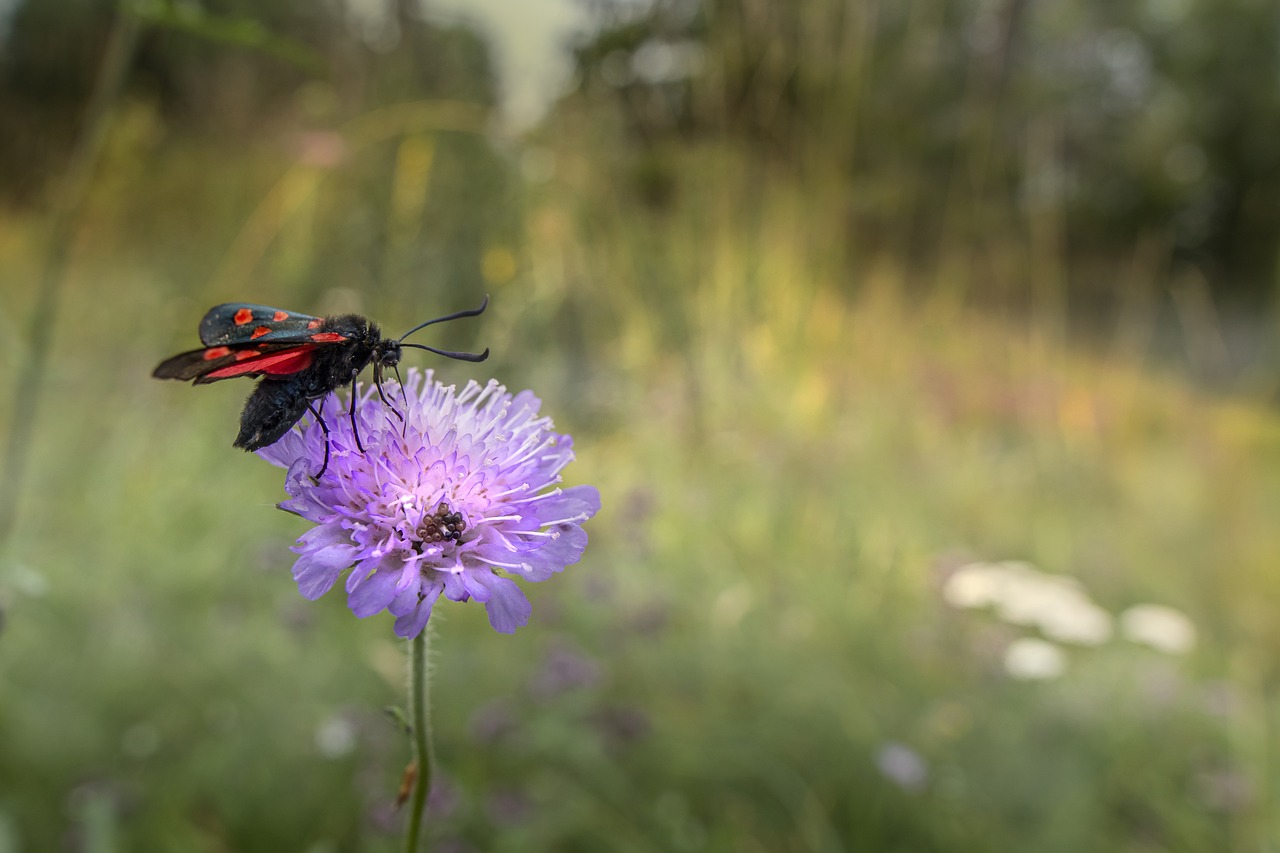🐛 Narrow-bordered Five-spot Burnet (Zygaena lonicerae) – In-depth Overview
🧬 Taxonomy & Classification
- Order: Lepidoptera
- Family: Zygaenidae (Burnet moths)
- Genus: Zygaena
- Species: Zygaena lonicerae
- Common Name: Narrow-bordered five-spot burnet
- Authority: Scheven, 1777
🦋 Identification
🔍 Adult Moth
- Wingspan: 30–40 mm.
- Coloration:
- Forewings: Metallic green-black with five crimson-red spots, often fused or elongated.
- Hindwings: Red with a narrow black margin.
- Borders: Distinctively narrow black edging around the forewing, distinguishing it from similar species.
- Body: Shiny, bluish-black with clubbed antennae.
🐛 Caterpillar (Larva)
- Appearance: Yellowish-green with black spots and short hairs.
- Shape: Plump and slug-like.
- Feeding: On host plants, mostly at night or early morning.
🐚 Chrysalis (Pupa)
- Formed in a white or yellowish silken cocoon attached to grass stems or leaves.
🌍 Distribution & Habitat
📍 Range
- Widespread across Europe, from the British Isles to Eastern Europe and parts of western Asia.
🏞️ Preferred Habitat
- Grasslands, meadows, roadside verges, chalk downlands, coastal dunes, and open woodland edges.
- Prefers areas with abundant wildflowers, especially vetches and trefoils.
⏳ Life Cycle
🔄 Voltinism
- Univoltine: One generation per year.
📆 Flight Period
- Adults fly from late June to August (varies by region and elevation).
🐣 Reproductive Cycle
- Eggs: Laid on the underside of host plant leaves.
- Larvae: Feed during late summer and again in spring after hibernation.
- Overwintering: As larvae in the grass base or leaf litter.
- Pupation: In early summer within a suspended silk cocoon.
🌿 Diet & Feeding
🐛 Larval Host Plants
- Specializes in Fabaceae (pea family), including:
- Bird’s-foot trefoil (Lotus corniculatus)
- Greater bird’s-foot trefoil (Lotus pedunculatus)
- Tufted vetch (Vicia cracca)
- Red clover (Trifolium pratense)
🦋 Adult Nectar Sources
- Attracted to wildflowers such as:
- Knapweed (Centaurea)
- Thistles
- Scabious
- Clover
⚠️ Defense & Mimicry
🔴 Aposematism
- Bright red and black coloration warns predators of toxicity (contains cyanogenic compounds).
- Birds quickly learn to avoid them after one unpleasant experience.
🧪 Chemical Defense
- Larvae and adults contain hydrogen cyanide, which deters predators.
- Can also synthesize cyanogenic glycosides from amino acids.
🔬 Ecological Role
- Pollinator: Contributes to pollination of various wildflowers.
- Prey: Limited natural predation due to chemical defenses.
- Bioindicator: Presence indicates species-rich meadows and unimproved grassland ecosystems.
☠️ Lookalike Species
| Species | Key Differences |
|---|---|
| Five-spot burnet (Zygaena trifolii) | More rounded spots, broader black borders, often more fused spots. |
| Six-spot burnet (Zygaena filipendulae) | Has six red spots per forewing, not five. |
| Cistus forester (Adscita geryon) | Smaller, metallic green moth, lacks red spots. |
Dissection or DNA analysis may be needed for certain Zygaena species with overlapping ranges.
📉 Conservation Status
- IUCN Red List: Not globally evaluated.
- Local Status: Stable in many parts of Europe but declining in others due to:
- Agricultural intensification
- Loss of species-rich meadows
- Pesticide use
- Conservation Measures:
- Protect unimproved grasslands.
- Encourage low-intensity grazing.
- Maintain wildflower diversity.
📖 Interesting Facts
- Day-flying moth: Often mistaken for a butterfly due to its coloration and activity during the day.
- Its red spots act as a universal warning — a visual signal shared with other toxic insects (a form of Müllerian mimicry).
- The species exhibits local variation in spot number and shape, leading to historical confusion with other species and subspecies.
📚 References & Further Reading
- UK Moths: Zygaena lonicerae
- Butterfly Conservation: Day-flying Moths Guide
- Waring, Townsend & Lewington (2017). Field Guide to the Moths of Great Britain and Ireland.
- Skinner, B. (2009). Colour Identification Guide to Moths of the British Isles.
Visited 819 times, 4 visit(s) today
Views: 769
Subscribe to the newsletter:
